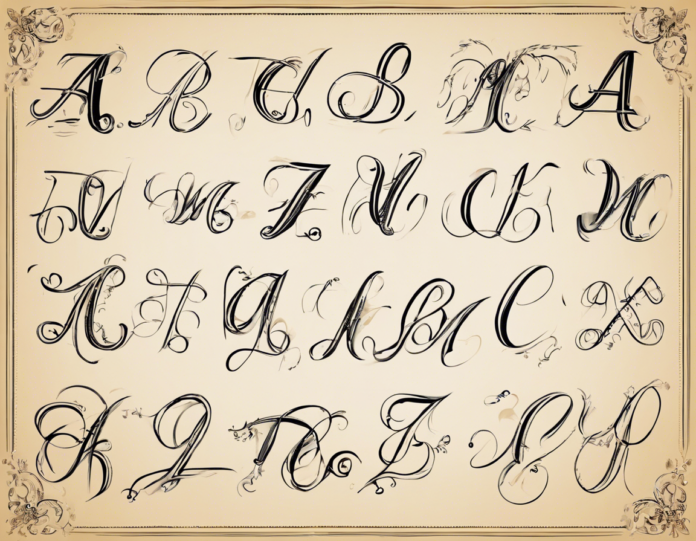Cursive handwriting is a timeless skill that has been taught in schools for generations. While the focus on cursive writing has waned in recent years with the rise of digital communication, many still find value in mastering this elegant and personal form of writing. Whether you’re looking to improve your own cursive handwriting or teach it to others, this comprehensive guide will take you through everything you need to know from A to Z.
Why Learn Cursive Handwriting?
Cursive handwriting offers a range of benefits beyond simply being a beautiful form of writing. Here are some reasons why learning cursive is still valuable in the digital age:
1. Fine Motor Skills Development
- Cursive handwriting requires hand-eye coordination and fine motor skills, making it a great exercise for developing dexterity.
- The fluid motions of cursive writing can help improve hand strength and coordination.
2. Enhanced Brain Connectivity
- Studies have shown that cursive handwriting can activate different parts of the brain compared to typing, leading to improved cognitive development and retention of information.
- Writing in cursive engages both hemispheres of the brain, promoting neural connections.
3. Personalized Touch
- Cursive handwriting adds a personalized and unique touch to your writing that digital fonts cannot replicate.
- Letters and words written in cursive can convey a sense of personality and style.
4. Historical and Cultural Significance
- Cursive handwriting has a rich history and cultural significance, with many important historical documents written in cursive.
- Learning cursive can help you appreciate and connect with the past through handwritten letters and manuscripts.
Getting Started with Cursive Handwriting
1. Understanding the Basics
- Before diving into cursive writing, familiarize yourself with the basic strokes and letter forms of the cursive alphabet.
- Practice writing individual letters in cursive to develop muscle memory and form.
2. Establishing Proper Posture and Grip
- Sit up straight with both feet flat on the floor and place the paper at a comfortable angle.
- Hold your pen or pencil with a tripod grip for optimal control and movement.
3. Practicing Consistently
- Set aside dedicated practice sessions to work on improving your cursive handwriting.
- Start with tracing exercises and progress to writing words and sentences in cursive.
4. Utilizing Online Resources and Worksheets
- Explore online cursive handwriting resources and worksheets to supplement your practice.
- Apps and websites offer interactive tools that can help you learn and improve your cursive writing skills.
Tips for Mastering Cursive Handwriting
1. Focus on Consistency and Fluidity
- Strive for consistent letter sizing and spacing to create a uniform and polished look in your cursive writing.
- Practice connecting letters smoothly to maintain the flow of your writing.
2. Pay Attention to Letter Formation
- Master the proper formation of each cursive letter, paying attention to entry and exit strokes.
- Practice writing letters in various combinations to improve your fluidity and speed.
3. Experiment with Different Styles
- Explore different cursive handwriting styles to find one that suits your preferences and comfort level.
- Try embellishments and flourishes to add a personal flair to your cursive writing.
4. Seek Feedback and Practice regularly
- Share your cursive writing with others to receive feedback and suggestions for improvement.
- Consistent practice is key to mastering cursive handwriting, so make it a regular part of your routine.
Common Challenges in Learning Cursive Handwriting
1. Legibility and Clarity
- Maintaining legible and clear cursive writing can be a challenge, especially when starting.
- Focus on forming each letter properly and practicing regularly to improve legibility.
2. Letter Consistency
- Ensuring consistency in letter sizing and spacing is essential for achieving a polished cursive writing style.
- Use guidelines or grid paper to help maintain uniformity in your writing.
3. Speed and Efficiency
- Balancing speed and legibility can be tricky in cursive writing.
- Start by practicing slowly and gradually increase your speed as you become more comfortable with the letters.
4. Overcoming Bad Habits
- Identify any bad cursive writing habits you may have picked up and work on correcting them.
- Focus on proper posture, grip, and letter formation to overcome these habits.
Frequently Asked Questions (FAQs) about Cursive Handwriting
Q1: Is cursive handwriting still taught in schools?
- A1: While cursive handwriting may not be as prominently featured in school curriculums as in the past, some schools still include it as part of their writing instruction.
Q2: What age is best to start learning cursive handwriting?
- A2: Children typically start learning cursive around ages 7-8, but it’s never too late to start honing your cursive writing skills at any age.
Q3: Can I teach myself cursive handwriting?
- A3: Yes, with dedication and practice, you can teach yourself cursive handwriting using online resources, books, and worksheets.
Q4: How long does it take to master cursive handwriting?
- A4: The time it takes to master cursive handwriting varies depending on individual dedication and practice routines. Consistent practice can lead to noticeable improvements in a few weeks to months.
Q5: Is cursive handwriting important in the digital age?
- A5: While digital communication is prevalent, cursive handwriting still holds value in personal correspondence, signature writing, and historical document reading. It also offers cognitive and creative benefits.
Mastering cursive handwriting requires patience, practice, and a willingness to learn and improve. By following the tips and techniques outlined in this guide, you can enhance your cursive writing skills and discover the joy of crafting beautiful handwritten letters and notes. Embrace the art of cursive handwriting and let your personal style shine through each elegant stroke of the pen.









